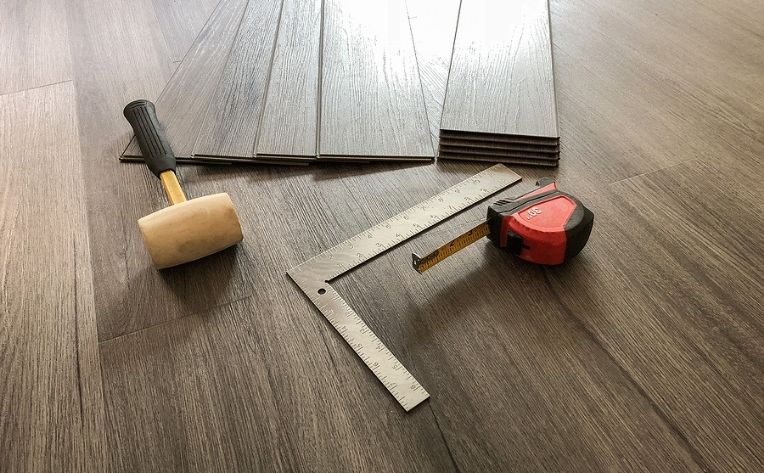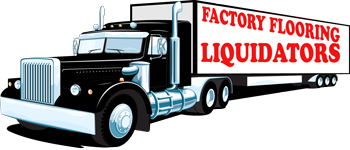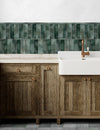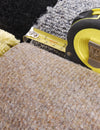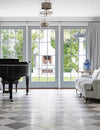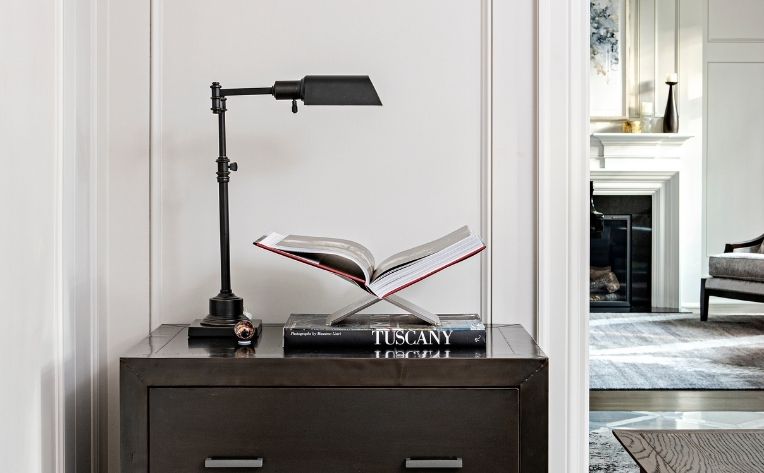
Photography by MIKE CHAJECKI
Written by KATE DAVIDSON | Design by KATE + CO DESIGN
For many of us, the remote work trend is here to stay, after almost two years of that “temporary” workstation in your home—gradually growing and evolving into what’s become an unsightly and unruly pile of paper and clutter. Perhaps this messy workstation has taken over your dining room table, the kitchen island, or a spot in your bedroom.
Unsurprisingly, the chaos of your ad hoc work area is affecting your life. Research shows that clutter negatively weighs on anxiety levels, stress, appetite, and sleep—not to mention the uninspiring aesthetic of this “war zone,” which you may be on the losing end of. But you don’t have to wave the white flag and surrender to the madness.
Here’s some advice that I’ve found to be helpful in my designs to help lift that weight so that you can work (and live) free!
Where to Locate Your Office in Your Home
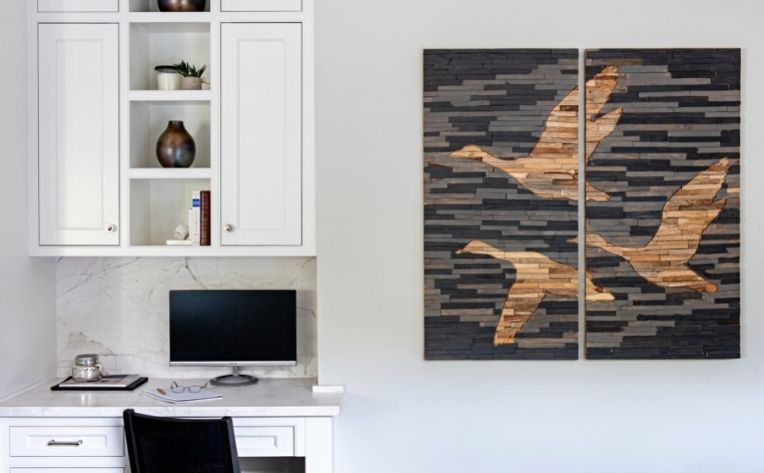 Photography by MIKE CHAJECKI
Photography by MIKE CHAJECKI
Although you can’t deny the flexibility and convenience of working from home, I’m a huge believer in the separation of professional and personal space. This provides privacy while working as well as the opportunity to shut the door on your workday and get some well-earned R&R. For this reason, I always encourage my clients to carve out a dedicated office area in their home. If you have a whole room to spare, with a door and a few other key essentials that I’ll get into, all the better. But remember, even where space is limited, you can still have a home office within a larger area of the home that brings function while meeting your aesthetic expectations.
As in real estate, when it comes to your home office, location is everything. Try to choose a space in your home that's separated from foot traffic. People coming and going via the main entrance, kids looking for snacks and backpacks, or the dog running laps around you can be counter-productive when you’re trying to focus, take a call, or participate in a virtual meeting. Find a quiet location away from the hustle and bustle, such as a spare bedroom, a spot in the basement, or a corner where you can tuck-in and plug-in for your workday.
If you’re setting up shop in a larger, open concept living area, as is often the case in many modern homes with open floor plans, you can define your office area by adding a rug that’s large enough to accommodate your desk and a few key pieces of office furniture. This anchors the area that’s delineated for office use. Then, create some separation and storage by adding a view-through bookcase between the workspace and living area. This will allow light to flow through while adding some privacy.
8 Office Essentials
Once you’ve figured out the “where” of your home office, determine what you’ll need to get the job done. Let’s focus on function first. Every office needs a desk, a chair, storage, lighting and ideally, a door to close come 5 p.m. However, depending on your role, you may also need to accommodate additional equipment, such as multiple computer monitors, a drafting table, and if you host meetings, a sitting area for colleagues or clients.
Let’s start with lighting. Arguably, this is the most important element in the room. Poor lighting is the culprit behind headaches and strained eyes, making it all but impossible to actually get any work done! Incorporate a layered lighting plan into your design, which includes ambient lighting, task lighting, and, if you choose, accent lighting. And if you have any natural light via a window, maximize that, too. If you’re in a basement or a dark corner, just ensure you have sufficient ambient lighting, which is the general overhead illumination in a space. Recessed lights are a great option. Task lighting, often in the form of a desk lamp or a floor lamp, would light your work area. Finally, accent lighting isn’t an essential per se, but it is a nice touch that works wonders for the ambiance of the space. Use it to highlight a collection of books, your favorite artwork, or some of your own work!
The next office essential is your desk and, by association, the chair. The biggest consideration for the desk is its dimensions—size and height. However, the desk chair is often underestimated. If you sit for long periods, be sure to give this some careful thought. It would be wise to take the chair for a “test drive” if possible. Even with online reviews, it can be difficult to gauge comfort from a photo and written description. Take a seat and consider support, adjustability, and even how you move as you work (think swivel seat or a chair on wheels.)
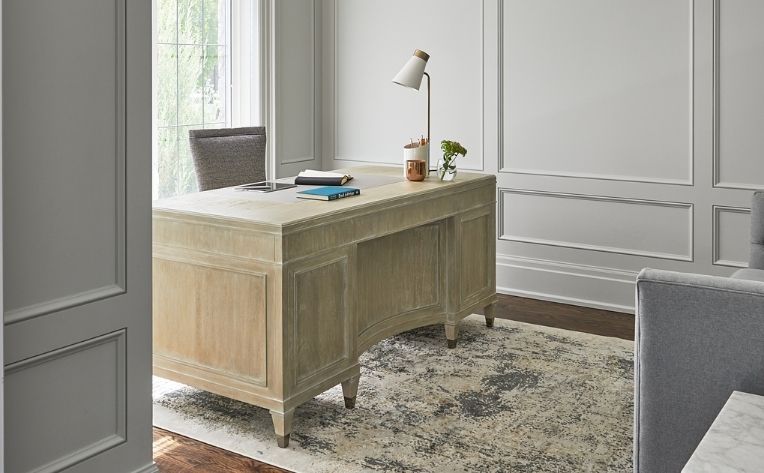 Photography by STEPHANI BUCHMAN
Photography by STEPHANI BUCHMAN
Storage space is always near the top of the list. One thing I’ve learned as a designer is that you can never have enough. “Stuff” accumulates quickly, so be sure to declutter regularly and plan to store the rest. Great storage areas don’t happen by chance. Put some thought into it. Storage solutions may include shelves, bookcases, filing cabinets, and the like. If your office is in a living area, be sure to factor style into your criteria, but more on that later!
TIP: Consider using multifunctional furniture whenever possible. By not cramming the room with unnecessary furniture, you’ll not only save on floor space (less can be more, people!) but on your budget, too.
The world has gone digital, and so can your filing system. Say “goodbye” to all that paperwork by transitioning to digital files that can be saved on your computer or cloud. This is a huge space-saver, not to mention it saves on paper and printing costs and is more environmentally friendly. Just do all your due diligence when it comes to backup and security!
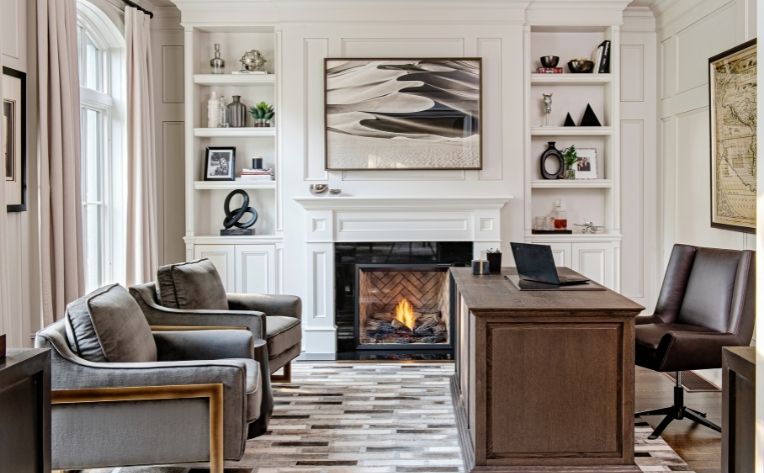 Photography by MIKE CHAJECKI
Photography by MIKE CHAJECKI
Last but not least, style. And yes, it’s on my list of office essentials. I firmly believe that every room in the home should be aesthetically pleasing, even “chore” rooms. In fact, it is here that I think some extra style could really work wonders: the laundry room, pantry, and, yes, the office. Think of it as being like a great business suit. Choose what inspires you because this can help yield some of your best work.
Try to work with your home’s existing aesthetic. That’s not to say the room needs to be a carbon copy of its neighbors. Take cues from your home’s color scheme and style but celebrate this unique part of the home with office-esque elements that reflect your professional persona.
Your home office can be everything you need functionally and everything you want aesthetically, regardless of its size. And there’s no reason it can’t be. If you need assistance, engage a designer, and there’s no shortage of interior decorating websites, magazines, and social media accounts—just a click away. Create your own inspiration board and put your vision into practice. Then, get busy! Of course, take a few moments throughout the day to put your feet up, look around, and take it all in. After all, you’ve earned it.
Need Help Installing Floors in Your Home? Ask the Experts at Factory Flooring
What type of underlayment should you use? How many inches thick? How do you install it? And how do you avoid damaging your floors in the process?
When you work with Factory Flooring, you don’t have to worry about these questions. Our team of professional flooring installers will handle all the heavy lifting for you — literally. All you have to do is relax and enjoy the savings on your energy bill.
Need to get more flooring ideas first? Our design blog has dozens of articles to help you get started. Whenever you’re ready to tackle your insulation project, we’ll be here to help. Contact us online to get started, or call Factory Flooring at 469-583-7053
